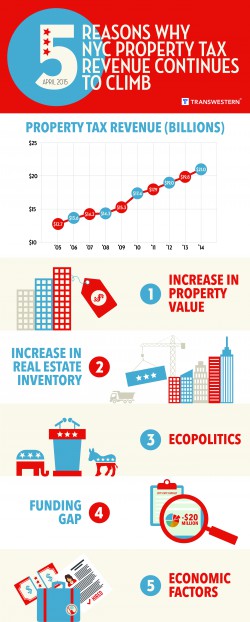 If taxes are on the brain, that’s only normal this time of year. They’re on everybody’s brain. Especially the good people of Transwestern, a privately held real estate company that does everything from development to structured finance.
If taxes are on the brain, that’s only normal this time of year. They’re on everybody’s brain. Especially the good people of Transwestern, a privately held real estate company that does everything from development to structured finance.
In preparation of the dreaded zero hour, Transwestern compiled figures published in “The City of New York, New York—Comprehensive Annual Financial Report of the Comptroller for the Fiscal Year Ended June 30, 2014,” which explained in one neat chart five reasons why New York City property taxes continues to climb.
“In most of the below-stated situations individuals can’t do much other can keep a track of the taxes, policies and legislature,” said Transwestern Researcher of Capital Markets & Leasing, Palak Raval, who compiled the data. “It’s important to be informed and make provisions for increased property tax revenue at least at the rate of inflation.”
Along with their findings (see graphic, left) they had this to say:
1. Here comes the pain—“Property owners should be prepared for a potential spike in appraised values,” said Transwestern’s Chief Accounting Officer Mike McLain. “And be prepared to go through the formal protest process with compelling data as to why their building should not be valued at the level the taxing authority has assessed.”
“This is inevitable in a growing economy,” counseled Ms. Raval. “Many times the city staggers the growth over three to five years in order to reduce the burden/impact.” To reduce the burden of the property owners, Ms. Raval points to the following exemptions and abatements:
* Individual owners of co-ops and condominiums can apply for co-op/condo property tax abatements.
* Commercial property owners would actually have a decrease in after-tax revenue due to increased tax bill—and certain types of properties (like religious organizations) are exempt from paying property tax.
* Most newly constructed housing development in New York City is eligible for a 10- to 15-year exemption under the city’s 421-a tax abatement.
* New York State also has exemptions for the disabled, crime victims, veterans, senior citizens, people with disabilities and properties with green roofs, solar roofs, or nonprofit organizations and agricultural properties.
2. Increase in real estate inventory—When there are new developments and/or construction in the city, more properties are included in the assessment bracket, leading to an increase in the property tax revenue.
“Increased development actually benefits existing property owners as it widens the tax base,” said Mr. McLain. “Governments looking to increase property tax revenue have only three avenues available: increase property values, increase rates or widen the base. Development and/or redevelopment of lower valued properties expands the tax base, which decreases pressure to increase valuations and/or the tax rate.”
“This does not directly affect the existing property owner,” added Ms. Raval, “but since newer properties are under the tax bracket, the city receives more property tax revenue.”
3. Ecopolitics—With increasing city expenses, if the city is unable to obtain additional state and federal aid, then making up the tax burden usually falls on property owners. If various tax abatements and exemptions—like 1031 or 421-a—are extended, this causes an increased reliance on property tax revenue and a rise in property tax rates.
“Other than engaging in the political process to ensure that rates aren’t increased significantly, property owners need to monitor their assessed values and make sure they don’t rise more quickly than the market to avoid shouldering more of the burden,” said Mr. McLain.
“Many big corporations in the sector can lobby regarding the issue, but again the end result is not always known,” said Ms. Raval. “There is no way an individual can prepare against this.”
4. Funding gap—“In case of a budget deficit, government reliance on property tax revenue increases,” said Ms. Raval, “however, in 2011 the New York Legislature enacted the New York State’s Property Tax Cap, which limits increases in school and local property taxes to 2 percent a year or the rate of inflation, whichever is less, with narrow limited exemptions while maintaining local control. Despite the legislature, local governments can pass a law or override the property tax levy limit. Cities, counties, towns and villages much hold a public hearing at which local officials must make their case to taxpayers.”
5. Economic factors—“The biggest driver of property tax revenues is assessed values of the underlying real estate, which may or may not directly cycle with other economic factors affecting a region,” said Mr. McLain. “If the governments choose to expand property taxes in a recession period, the likely only avenue is increasing the rate to offset the depression in assessed values and lack of development activity to widen the base, which might also further depress economic activity. Monitoring legislative activity on tax rates and continuing to monitor and minimize assessed values are the primary tax strategies available to property owners.”
Ms. Raval added: “When the overall economy is in a healthy state—Wall Street is performing well, unemployment level is low, personal income of individuals is increasing, tourism in the city is on the rise—government receives revenue from multiple sources and there is an overall increase in revenue. So during those times the reassessment of the properties can also be postponed or staggered over the coming years. Hence the property owners don’t face rising property taxes. It’s an opposite case during recessions.”


